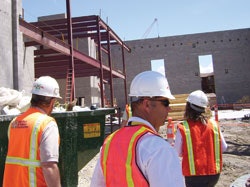Owners of new and renovated facilities are benefitting from a national move toward uniform building and life-safety codes.
 Photo of a building code official surveying a facility under construction
Photo of a building code official surveying a facility under constructionRecreation program administrators go into any construction or renovation project knowing that they will have to satisfy the desires of multiple constituencies - the board of directors or school administration, the students or membership, the donors or stakeholders, and secondary user groups or (on college or high school campuses) the athletic department as a whole or particular sports team coaches. What many fail to recognize, in their excitement over creating new, state-of-the-art program space, is that there is someone whose satisfaction with the building plan is the most vital of all - the building code official.
"Satisfying code," which is standard parlance, refers to meeting the requirements of a very large document that details the local jurisdiction's understanding of how to keep buildings and building occupants safe in the event of fire or other natural disasters. Satisfying a code official, who interprets this document, is something else altogether. Because building codes, as written, are general, building code officials can hold up a project or insist on alterations to the building plan or expensive additions based on their own ideas of what the codes require. Since a recreation center is a machine with many moving parts and may well be the only such building within a particular jurisdiction, the code official may insist on requirements that are sure to seem ridiculous to anyone familiar with the building type.
"You really don't want codes made too specific, because a building code can't anticipate every possible situation," says Dick Evenson, senior vice president of group services for The RJA Group, a fire protection and life safety consultancy. On the other hand, Evenson says, there's nothing more frustrating than obstacles created by a person who "sometimes doesn't even understand something as simple as a Holidome, where it's just a use other than a hotel in a hotel building. There are times you have to spend a lot of time making sure the code official understands it isn't a sports facility, it's a hotel with a swimming pool."
While such oversight is technically the responsibility of the architect or contractor, prudence suggests a building owner ought to know a little something about codes, too. The owner is the person with the greatest knowledge of how the organization's facility needs may change over time, and all future changes will have to satisfy code. More than that, Evenson says, the owner will be the liable party if something bad should happen.
"Ultimately, the owner will be held responsible for compliance with the code," he says. "That's what the code says. The owner will try to shift that responsibility to the designer, and a certain amount of that shifting can happen. But when the fire occurs, you, the owner, are going to get named first. You can't just rely on your building professionals."
Though still complicated for the layperson to understand, codes have gotten significantly more cohesive during the past decade. As recently as 2002, three separate codes existed on the national level that, through the efforts of the International Code Council, have since become one - the International Building Code (IBC), which is now the de facto U.S. standard. A separate code, the NFPA 5000, administered by the National Fire Protection Association, exists mainly as supporting fire-safety standards for IBC. In addition, the amount of time it takes for new concepts or technologies to be codified is, by all accounts, getting shorter - with about three years between editions of a code, changes start to appear in two or three cycles these days, Evenson says, rather than four or five cycles.
Codes cover structural considerations - will the building stay standing? - as well as electrical, plumbing and other mechanical issues. However, a high percentage of codes are written with fire safety in mind, requiring both physical alterations (the installation of sprinkler systems and fire-retardant coatings, to cite two examples) and the use of theoretical models that can severely impinge on the building plan.
For instance, the most basic of life-safety considerations involves the number of people who are presumed to be able to safely exit a building in the case of a fire. In a spectator facility, it is easy to count the number of seats in the building and design staircases and concourses, and lobbies and doors, to handle the flow of that number of people to the outside.
Unfortunately, codes (and especially code officials) have not quite gotten the hang of estimating the number of people likely to be inside a multipurpose recreation center. Most simply use the same figure for occupant load that they might use for a spectator facility, a practice that drives architects to distraction. "Fifteen is a magic number for some code officials," says Keith Fuchigami, a vice president with Cannon Design in Los Angeles, referring to the number of square feet per occupant. "Some even want to estimate 7 or 10 square feet per person. Code puts those under what are called 'assembly spaces,' and in their minds, gyms and jogging tracks are assembly spaces, with 15 being the number to use for less heavily used types of activities."
Do the math, though, and you'll soon be as incredulous as Fuchigami.
"Fifteen years ago, they added an 'athletics' category, and it's really meant for spaces such as weight and fitness rooms, and that's 50 square feet per person. But most building officials won't let you use that for a racquetball court. Divide the 800 square feet of a racquetball court by 15, and that makes the occupant load 53, which is just stupid. A typical two-court gym of maybe 14,000 square feet makes the occupant load 933. If you're just doing basketball games with no seating, that's crazy."
Since all the numbers from all the activity spaces are added up to determine the building occupancy, the 400 people who are supposedly on your three-lane jogging track simultaneously are going to cause you to spend a lot more money on your building in the form of exit doors, plumbing fixtures, air-handling units and the simple bricks and mortar it will take to accommodate the extra circulation space. Many code officials can be persuaded to use lower figures - Fuchigami says it helps if they've played racquetball or visited a recreation center - but the fact that it's up to a local official "to decide what he's going to make you do" still grates.
"There have been great strides made in assigning more appropriate square footage for some activity spaces," says Erik Kocher, a principal at St. Louis-based Hastings & Chivetta Architects. "But there are still code officials who - you know, you're a paid civil servant, and you want to take no risks, so why would you change from the written code? They'll insist that 'recreation' is the same as 'assembly,' but conceptually they're two different things. By code, a 125,000-square-foot rec center will hold 6,000 people - even if it's on a college campus of 4,000. We still have different officials interpret that differently."
Code officials will have different interpretations, in fact, even of certain physical code requirements that seem like they ought to be standard in all buildings - the recreation center equivalent of, say, the "one outlet every 6 feet" of residential-construction electrical codes. "The fire marshal reviewing your building will say, 'I want fire extinguishers every 75 feet per code,' " says Chris Kastelic, a principal with Denver-based Sink Combs Dethlefs. "But another fire marshal in the same jurisdiction might say, 'I don't care where you put fire extinguishers. If there's a fire alarm, I want people out of the building, I don't want them looking for a fire extinguisher.' There can be a whole different mentality for how you should protect buildings and building occupants."
To cite another example, it should be a simple matter to locate fire sprinklers over spaces that can catch fire and burn, with the individual sprinkler heads at specific intervals to provide ample coverage in those areas. Sprinklers, though, are not so simple if a code official sticks to the letter of the code rather than the spirit. Code requires them in every part of a recreation center, including over the pool deck, of all places. A code official might also require them on gym and atrium ceilings so tall that, as Kocher notes, the water would have "no effect, because the water evaporates before it hits the floor and isn't concentrated enough to put out the fire."
"One that kills us is sprinklers in racquetball courts," says Kastelic. "You have to have them, but there's no such thing as heavy-duty concealed or recessed sprinkler heads - so inevitably a ball hits the sprinkler and busts the solenoid, and you just bought yourself a new racquetball court floor."
A suspended jogging track, meanwhile - something that a recreation professional would consider pedestrian - will be no walk in the park for the code official who looks over the drawings, or the second code official who comes to the facility during construction and overrules the decisions of the previous code official (a common situation, says Kocher). Since sprinklers are often among a facility's last additions, notes Ann Drummie, senior project manager with Washington, D.C.-based Brailsford & Dunlavey, the code official's walk-through may prompt last-minute change orders - especially if, in the official's determination, the jogging track is likely to be used as an emergency egress path. (Some code officials will insist on sprinklers if an exit door is located directly off the track, Drummie says.)
"My argument would be that the users of a jogging track are all running, so that area will clear out in a fire faster than any other space in the building," Kocher says, only half joking, adding that the code seems redundant in this case. "A suspended jogging track is a piece of structure hanging in a bigger piece of structure that is already protected with a sprinkler system. We've built 120 of these facilities with suspended tracks, and we don't ordinarily have to protect them, but there was one recent case we had an unaccommodating code official come in and require us to put sprinklers over it and use a spray-on intumescent paint on the underside, which we then had to hide with a gypsum bulkhead."
Those extra costs, though not insignificant, pale in comparison to the cost of designing a recreation center with toilets for 6,000 people. Says Kocher, "A rec center at its capacity might hold 500 people. You can do the math - here's a basketball court with two teams playing and two waiting, here's a racquetball court with two, four or eight players for Wallyball. There's code occupancy and there's real occupancy. You'd think that, realistically, you wouldn't have to deal with any of these things. Well, sometimes you do, sometimes you don't. You're at the whim of the inspector."
Because code officials are, after all, just people, their minds can be changed with a little convincing. But successfully negotiating the code review process starts much earlier, Evenson says.
"If architects are getting caught short at the last minute, I'd say that's because they're not talking with building officials early enough to be sure they understand how that local official is interpreting the code," Evenson says. "To start with, you wouldn't get as specific as talking about individual system components, but you need to understand the lay of the land. When we go into a new jurisdiction, we find out who the code officials are, and who's going to do the reviewing, and we might make a preliminary visit with them during the schematic phase of the design. You want to get a dialog going so you don't end up late in the construction document phase, finding out that 'No, you can't do that in this jurisdiction.' Because, even if they're using IBC as a model building code, they may have made modifications to it."
Most experienced sports architects have become deft in their approach to codes, finding certain semantic loopholes that help avoid code entanglements. To cite one example, as long as a track is located on a structure that is less than one-third the square footage of the first floor over which it is hung, it can be branded a "mezzanine," which requires less stringent fire code requirements. Also, "multipurpose room" used in place of "aerobics room" - this was already a natural transition in most recreation centers - helps prevent a code official from identifying it as a classroom, which would bring with it a higher occupant load.
But an architect's greatest guard against code snafus is making sure the client knows exactly what activities will occur in every space in the building. Spaces intended purely for recreation can be negotiated; a building owner wanting to keep his or her options open in terms of assembly use is pretty much guaranteeing a battle with code officials. "If you are going to use your gym for a dance," says Fuchigami, "you'd better be honest about it."
Because renovations open up a host of code issues (see "Code Words," below), code officials may want building owners to put their long-term plans in writing. Beyond pledging that the gym won't host the school prom, this might mean trying to anticipate a college's future enrollment growth. "We've worked on campuses where they have an agreement with the jurisdiction that says, 'We're maxing here in terms of student population,'" Kocher says. "Unless they come back with a new campus master plan and negotiate code issues with them, this is where they're going to stay, student-wise."
In the event the negotiation fails to produce something in line with the building owner's needs or expectations, the IBC code spells out an appeal process. Primarily, the architect's role in such a circumstance, as with earlier negotiations with the particular code official, is to demonstrate "equivalency" to the code with regard to "means and materials."
"You should win more than you lose," Evenson says, "simply because most of the time when an official is uncomfortable making a ruling, it's because he is being asked to allow something that nobody else has been allowed to do in that jurisdiction, and he just wants another party to look at it."
Beyond "praying you get an official who understands common sense," Fuchigami says building owners can help the process along by understanding more about their future rec center than just the beautiful exterior.
"The reason they look the way they do is the people in charge knew what to negotiate," says Fuchigami. "Make sure you understand how you can get what's in your mind's eye while meeting the building code. Otherwise, your building's not going to look like the ones you see in pictures."
Code Words
Codes not only tell you the little things - the required number and location of sprinkler heads, for example - they also specify how big of a rec center you can build. This not only informs present-day construction decisions, but also future expansion of planned buildings and renovations of existing structures. Buildings are classified under code by the materials used to construct them, from type 5 (wood frame construction) to type 1 (steel construction, with fireproofed exterior walls and roofs, ceilings and other requirements), as well as by occupancy type (high school, college and so on). If your existing college rec center is type B-3, for instance, and is already the maximum size allowed under code for buildings of this type, your hoped-for expansion will not technically meet code, and must therefore be finessed. This is typically handled by renovating the existing structure where it joins with the expansion, with a sort of enclosed gap between the two structures. Requirements include sufficiently fire-rated walls on either side of the gap and limitations on wall openings, allowing code officials to view the expansion as a separate structure, even if to the untrained eye the new recreation center will appear seamless.
To ensure that building owners face as few expansion limitations as possible down the road, Keith Fuchigami of Cannon Design in Los Angeles pushes clients looking to build recreation centers in the direction of type 1 buildings, though as he points out, most of these buildings will already tend toward type 1 construction.
"With a type 1, whatever they want to do in the future, they can keep adding and adding without having to worry about it," Fuchigami says. "It can add to the up-front cost of the building if you were budgeting for a different type of construction, but it's really kind of a slam-dunk."




































